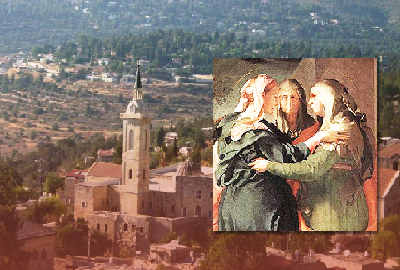From the hills of Galilee, Mary heads south….
After having welcomed the Word wholeheartedly, she allows it to lead and accompany her. This is what the Word does when it is accepted: it fills us and accompanies us on our jour-ney through life. The angel of the Annunciation (Gabriel = “God is my strength”) greets Mary with the words: “Hail, full of grace! The Lord is with you” (Lk. 1:28). The grace of God floods a person’s life, causing a new certitude to blossom, namely: God is with me! He is with us! When this happens, new horizons open before us.
But the Word does another thing when it is welcomed: it opens our eyes to the needs of our sisters and brothers. It enables us to see what others don’t see. It helps us to understand things that others don’t understand. It prompts us to follow unfamiliar paths. The Word never abandons those who believe in the good things it promises. Listening to the Scriptures, we adopt God’s way of thinking; we see situations through his eyes, we listen to people with his heart. This is what Moses experienced on Mt. Horeb when he met God in the burning bush. He lis-tened to the divine voice, but above all he heeded the call to become concerned about the things God is concerned about. Moses wanted to see God and instead God prompted him to take a look at what was going on around him: “I have seen the misery of my people and I have heard their cry. I am aware of their sufferings. Their laments have reached my ears and I have seen for my-self how the Egyptians are oppressing them. So, get out there! I am sending you to Pharaoh. Lead my people out of Egypt!” (cf. Exodus, Chapter 3) Like Moses, Mary understands that God is sending her to his people: in her case, to a specific situation, a specific family and a specific person. “Elizabeth, your relative, has also conceived a son in her old age, and this is the sixth month for her who was called barren” (Lk. 1:36).
From Nazareth, Mary heads south into unfamiliar territory. The school of the Word urg-es us to go beyond our habitual boundaries and to willingly accept the discomforts this involves. If we insist on remaining in our usual surroundings, doing what we do best, we run the risk of grinding to a halt on our trip through life. Mary is propelled out of her “comfort zone” because Elizabeth needs her.
But she has to make a long and tiring trip to reach her cousin. It is odd that the Gospel does not tell us precisely where Mary was headed even though tradition informs us that the Vis-itation took place in the village of Ain Karem, located about 8 km. from Jerusalem. The etymolo-gy of the town’s name (“Vineyard made fruitful by a perennial wellspring”) is symbolic of this encounter because it was the place in which the Lord, the Wellspring of perennial grace, trans-formed sterility into fertility.
But the Bible does not mention Ain Karem specifically; it talks about “a town of Judah in the hill country.” Where in Judah? What town? And in what part of the town was Zechariah’s house located? We don’t have any information about this, probably as an incentive to intensify our research…. And perhaps, after all, the meaning of the Visitation is to be found in our daily lives. It is not easy to reach out to others and assist them. We have to get to know their situa-tions and learn their “language.” We have to meet them eye to eye and grasp their needs. We have to look at things differently and interpret our faith in a new way. Helping others involves exploring a whole new world!
Every person is a mountain to scale and the “handholds” and other supports we need to grasp along the way are sometimes not easy to find. Every person is a mysterious and fortified city (cf. Jr. 1:18), surrounded by high walls and gates. But every person is above all a dwelling place–a space that encompasses all the fragile and intimate aspects of that individual’s life; a place where we must remove our footgear before entering because we are treading on sacred ground!

